Abstract
The stability of type 2 dengue virus to exposure to a variety of laboratory conditions was determined. Suckling mouse brain passage virus was adapted for growth in BHK-21 cells, and plaque assays were performed using a tragacanth gum overlay. A three- to fourfold increase in plaque size could be obtained if monolayers were subconfluent at time of inoculation. Incubation of virus for 24 h at 37 degrees C, pH 6.5, or in buffer containing 1 mM ethylenediaminetetraacetate considerably reduced virus infectivity as compared with virus incubated for the same period at 4 degrees C, pH 8.0, or in buffer with or without 1 mM CaCl2 and 1 mM MgCl2. Multiple freezing and thawing of virus tissue culture medium containing 10% fetal calf serum did not reduce virus infectivity.
Full text
PDF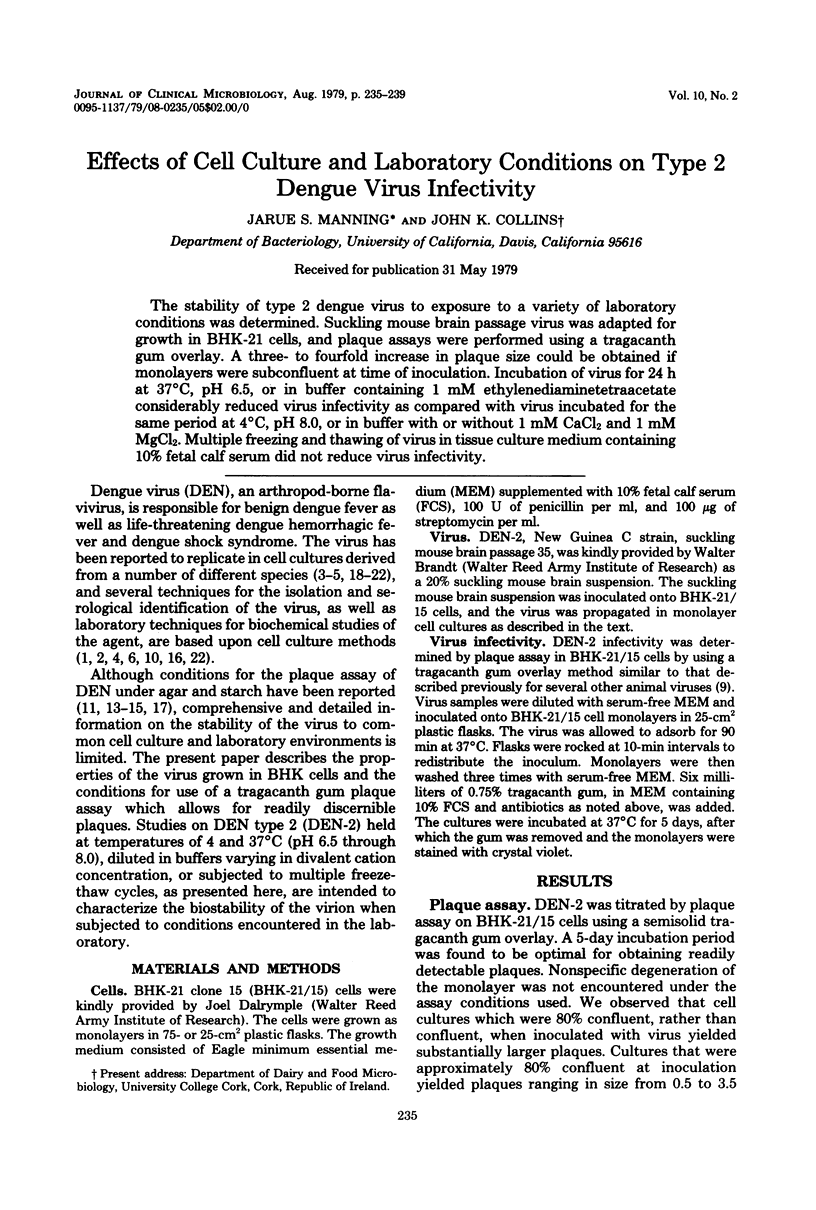
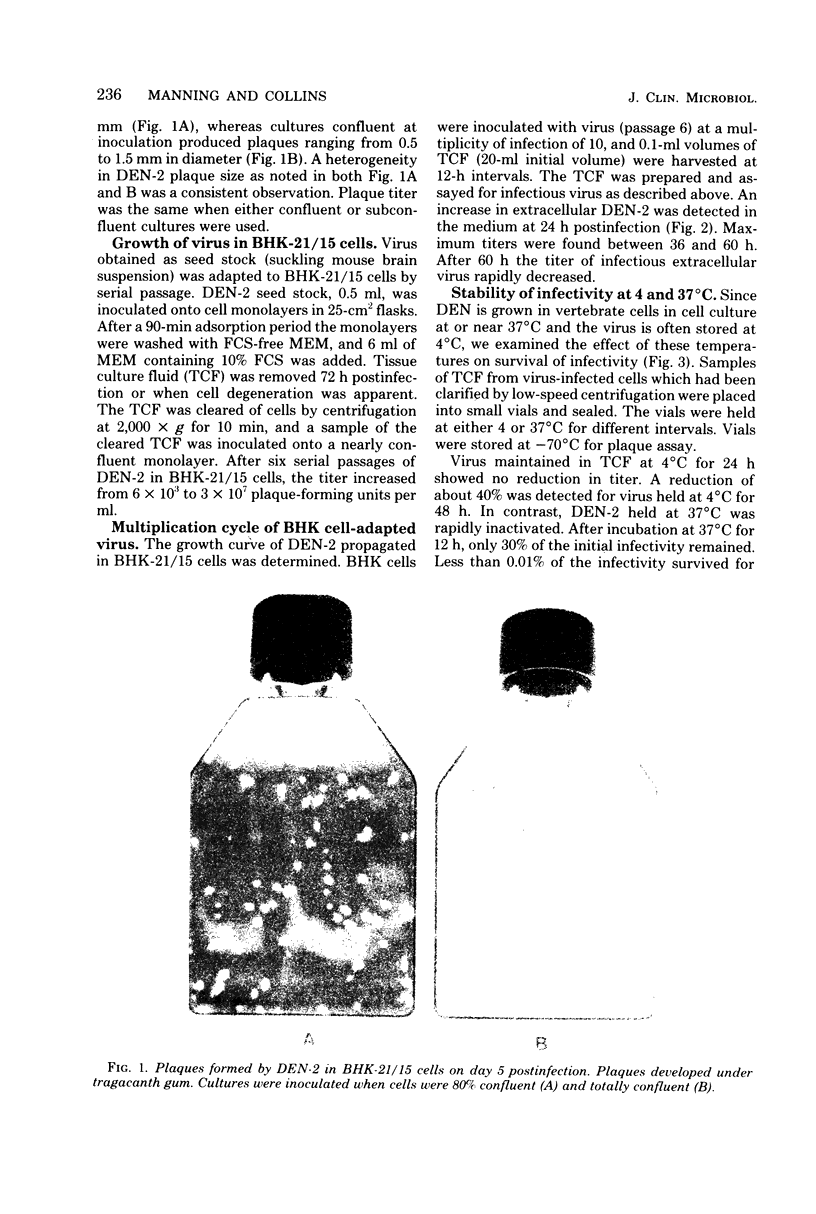
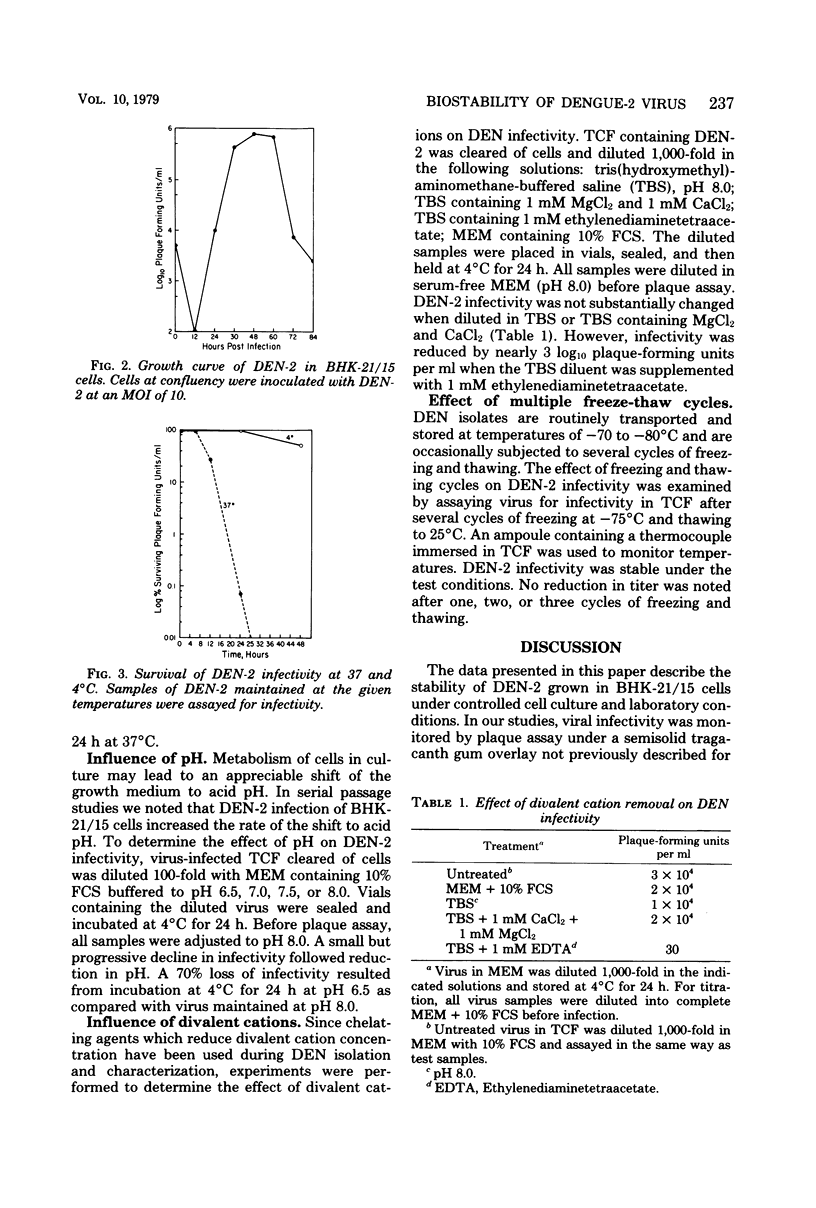
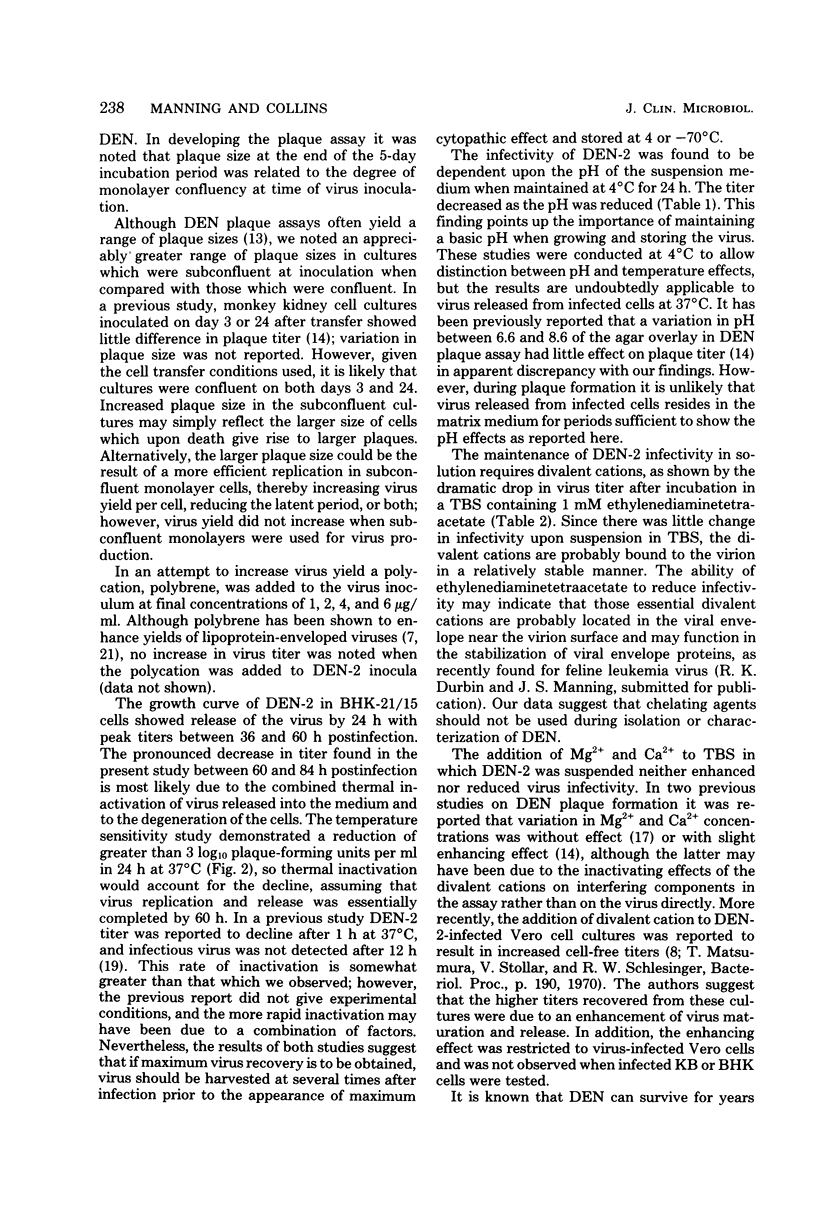
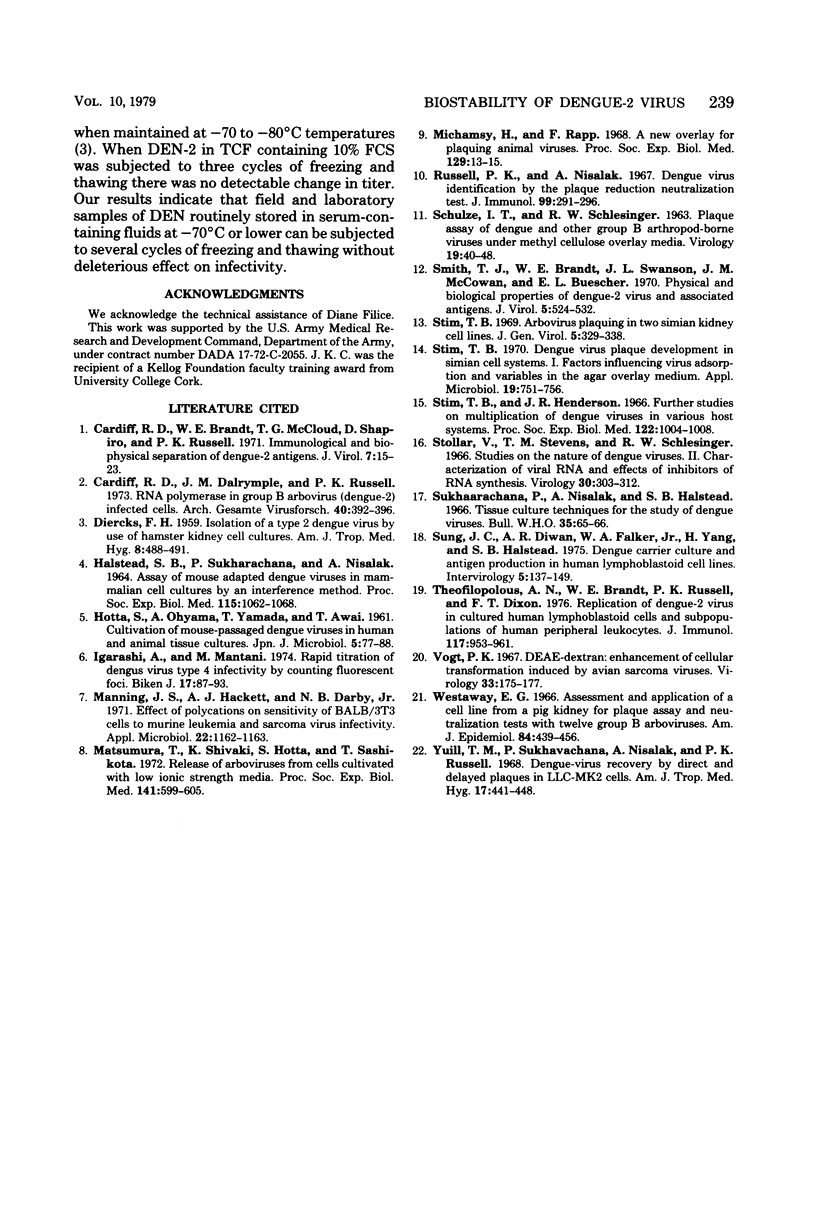
Images in this article
Selected References
These references are in PubMed. This may not be the complete list of references from this article.
- Cardiff R. D., Brandt W. E., McCloud T. G., Shapiro D., Russell P. K. Immunological and biophysical separation of dengue-2 antigens. J Virol. 1971 Jan;7(1):15–23. doi: 10.1128/jvi.7.1.15-23.1971. [DOI] [PMC free article] [PubMed] [Google Scholar]
- Cardiff R. D., Dalrymple J. M., Russell P. K. RNA polymerase in group B arbovirus (dengue-2) infected cells. Brief report. Arch Gesamte Virusforsch. 1973;40(3):392–396. doi: 10.1007/BF01242561. [DOI] [PubMed] [Google Scholar]
- DIERCKS F. H. Isolation of a type 2 dengue virus by use of hamster kidney cell cultures. Am J Trop Med Hyg. 1959 Jul;8(4):488–491. doi: 10.4269/ajtmh.1959.8.488. [DOI] [PubMed] [Google Scholar]
- HALSTEAD S. B., SUKHAVACHANA P., NISALAK A. ASSAY OF MOUSE ADAPTED DENGUE VIRUSES IN MAMMALIAN CELL CULTURES BY AN INTERFERENCE METHOD. Proc Soc Exp Biol Med. 1964 Apr;115:1062–1068. doi: 10.3181/00379727-115-29117. [DOI] [PubMed] [Google Scholar]
- HOTTA S., OHYAMA A., YAMADA T., AWAI T. Cultivation of mouse-passaged dengue viruses in human and animal tissue cultures. Jpn J Microbiol. 1961 Jan;5:77–88. doi: 10.1111/j.1348-0421.1961.tb00763.x. [DOI] [PubMed] [Google Scholar]
- Igarashi A., Mantani M. Rapid titration of dengue virus type 4 infectivity by counting fluorescent foci. Biken J. 1974 Sep;17(3):87–93. [PubMed] [Google Scholar]
- Manning J. S., Hackett A. J., Darby N. B., Jr Effect of polycations on sensitivity of BALD-3T3 cells to murine leukemia and sarcoma virus infectivity. Appl Microbiol. 1971 Dec;22(6):1162–1163. doi: 10.1128/am.22.6.1162-1163.1971. [DOI] [PMC free article] [PubMed] [Google Scholar]
- Matsumura T., Shiraki K., Hotta S., Sashikata T. Release of arboviruses from cells cultivated with low ionic strength media. Proc Soc Exp Biol Med. 1972 Nov;141(2):599–605. doi: 10.3181/00379727-141-36831. [DOI] [PubMed] [Google Scholar]
- Mirchamsy H., Rapp F. A new overlay for plaquing animal viruses. Proc Soc Exp Biol Med. 1968 Oct;129(1):13–17. doi: 10.3181/00379727-129-33237. [DOI] [PubMed] [Google Scholar]
- Russell P. K., Nisalak A. Dengue virus identification by the plaque reduction neutralization test. J Immunol. 1967 Aug;99(2):291–296. [PubMed] [Google Scholar]
- SCHULZE I. T., SCHLESINGER R. W. Plaque assay of dengue and other group B arthropod-borne viruses under methyl cellulose overlay media. Virology. 1963 Jan;19:40–48. doi: 10.1016/0042-6822(63)90022-9. [DOI] [PubMed] [Google Scholar]
- Smith T. J., Brandt W. E., Swanson J. L., McCown J. M., Buescher E. L. Physical and biological properties of dengue-2 virus and associated antigens. J Virol. 1970 Apr;5(4):524–532. doi: 10.1128/jvi.5.4.524-532.1970. [DOI] [PMC free article] [PubMed] [Google Scholar]
- Stim T. B. Dengue virus plaque development in simian cell systems. I. Factors influencing virus adsorption and variables in the agar overlay medium. Appl Microbiol. 1970 May;19(5):751–756. doi: 10.1128/am.19.5.751-756.1970. [DOI] [PMC free article] [PubMed] [Google Scholar]
- Stim T. B., Henderson J. R. Further studies on multiplication of dengue viruses in various host systems. Proc Soc Exp Biol Med. 1966 Aug-Sep;122(4):1004–1008. doi: 10.3181/00379727-122-31310. [DOI] [PubMed] [Google Scholar]
- Stollar V., Stevens T. M., Schlesinger R. W. Studies on the nature of dengue viruses. II. Characterization of viral RNA and effects of inhibitors of RNA synthesis. Virology. 1966 Oct;30(2):303–312. doi: 10.1016/0042-6822(66)90105-x. [DOI] [PubMed] [Google Scholar]
- Sung J. S., Diwan A. R., Falkler W. A., Jr, Yang H. Y., Halstead S. B. Dengue carrier culture and antigen production in human lymphoblastoid lines. Intervirology. 1975;5(3-4):137–149. doi: 10.1159/000149891. [DOI] [PubMed] [Google Scholar]
- Theofilopoulos A. N., Brandt W. E., Russell P. K., Dixon F. T. Replication of dengue-2 virus in cultured human lymphoblastoid cells and subpopulations of human peripheral leukocytes. J Immunol. 1976 Sep;117(3):953–961. [PubMed] [Google Scholar]
- Vogt P. K. DEAE-dextran: enhancement of cellular transformation induced by avian sarcoma viruses. Virology. 1967 Sep;33(1):175–177. doi: 10.1016/0042-6822(67)90109-2. [DOI] [PubMed] [Google Scholar]
- Westaway E. G. Assessment and application of a cell line from pig kidney for plaque assay and neutralization tests with twelve group B arboviruses. Am J Epidemiol. 1966 Nov;84(3):439–456. doi: 10.1093/oxfordjournals.aje.a120657. [DOI] [PubMed] [Google Scholar]
- Yuill T. M., Sukhavachana P., Nisalak A., Russell P. K. Dengue-virus recovery by direct and delayed plaques in LLC-MK2 cells. Am J Trop Med Hyg. 1968 May;17(3):441–448. doi: 10.4269/ajtmh.1968.17.441. [DOI] [PubMed] [Google Scholar]



